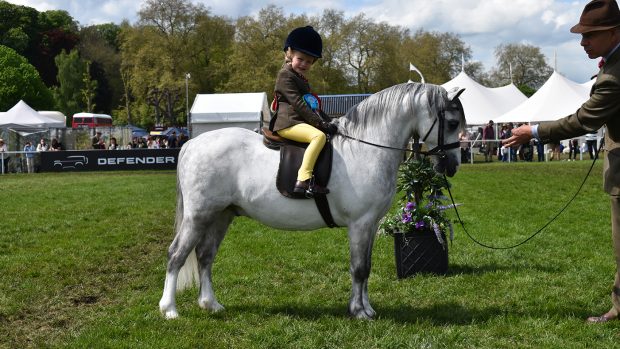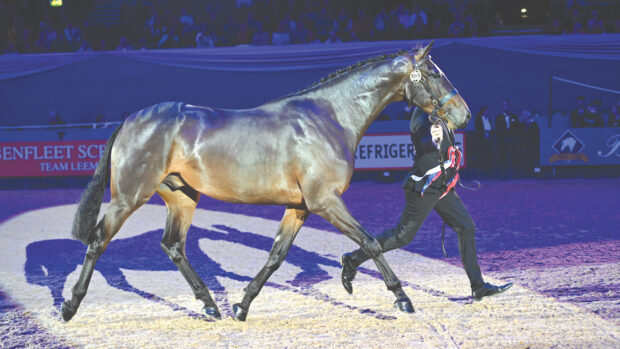With seven different native breeds making up the large breed mountain and moorland (M&M) classes, standing out from the crowd can be a challenge.
Read H&H’s guide to M&M large breed classes, including tips to ensure you make an instant impact and help you avoid any pitfalls:
Breeds and origins
M&M ponies form a group of several breeds of ponies native to the British Isles. Many of these breeds are derived from semi-feral ponies kept on moorland or heathland, and some of them still live in this way, as well as many now being kept as fully domesticated animals for riding and driving purposes.
-
- Connemara ponies come from County Galway in western Ireland
- Highland ponies hail from Scotland
- Dales ponies derive from the eastern Pennines in north England
- Fell ponies are from Cumbria in north-western England
- New Forest ponies come from the New Forest in Hampshire on the south coast of England
- Welsh ponies (section C and D) originate from Wales
Class options
M&M ponies are usually divided into two categories – small and large. The ridden large breed ponies must be four-years-old and over and registered in the approved pure breed society stud books of the Connemara, Highland, Dales, Fell, New Forest and Welsh sections C and D. Riders can be any age, apart from in mini and junior classes where relevant age restrictions apply.
Three societies govern the championship classes, including qualifiers for Horse of the Year show (HOYS), Royal International Horse Show (RIHS) and the M&M supreme ridden championship, to be held at the Liverpool International Horse Show for the first time in 2021/2022.
-
- National Pony Society (NPS)
- British Show Pony Society (BSPS)
- UK Horse and Ponies (UKHP) (formerly Ponies UK)
What does the judge expect?
Riders in native pony classes will be expected to perform an individual show and will not be ridden by a judge. The ponies will also be assessed for conformation and breed type, either in-hand or under saddle depending on the level of the class.
“In M&M classes I’m looking for ponies that best meet their own particular breed standard,” says NPS judge Gill Wright.
“It’s important that the ponies exhibit the type characteristics, both in conformation and action that are defined in their own breed description, and are trimmed to their breed’s individual specification.”
“The body shape I prefer in natives is that of a deep bodied pony that would be tough and hardy,” adds Gill, who also runs her own Burley Stud breeding New Forest ponies. “The depth of body should match the length of leg.
“This general body type is better adapted for living in the fairly hostile environments from where most of our native breeds evolved. Many tend to be broad at the withers, which shows their multi purpose heritage.
“Large breeds should have plenty of hard flinty bone, well-formed round feet and be capable of carrying considerable weight.”
Turnout
Breed societies all produce their own rules for the native breeds, so make sure you are aware of them and follow them.
Tack should be made of plain leather and should be workmanlike and suit the pony. Only use brown or black tack and only use a plain browband. No boots or bandages are permitted. Choose a discreet numnah that matches the pony and saddle and is barely visible.
Choose a snaffle bridles for novice classes and a double bridle or pelham for open classes.
Saddle wise, a straight cut or working hunter saddle is preferred as they show more of the shoulder and movement. These types are preferable to general-purpose saddles.
Most importantly, natives are to be shown in natural state and manes, tails and feathers are pulled or trimmed in some breeds. Ensure you check with the breed society’s specifications.
“Make sure your pony goes happily in your chosen bridle rather than unhappily in a double because you think that you have to use it,” adds Gill. “Riders in all classes should wear tweed jackets, breeches or jodhpurs, shirt and tie and current standard riding hats.”
Way of going
“The way of going varies considerably from breed to breed depending on the uses for which the ponies were bred for in their own particular original environment,” says Gill. “It is vital that ponies exhibit the correct movement and way of going for their own breed.
“Fells, Dales and Welsh cobs in particular should show personality and a very active trot, which in many ways is the most important pace for those breeds, so every effort must be made to emphasise this gait.
“I like to see New Forest and Connemara ponies give a smooth, polished show with a really good gallop, while Highlands should show a ground covering walk together with a well balanced show.”
Walk
“In general I like to see relaxed swinging walk,” says Gill. “The walk is a very important pace and riders should ensure that their individual show demonstrates this.”
Trot
“The trot should be active, free and straight with powerful, active use of the hocks.”
Canter and gallop
“The canter should be light, balanced, rhythmical, but should also show some personality. Natives should show a good extension in gallop, lengthening and lowering over the ground, pulling up when asked in a controlled and accepting manner.
“All transitions should be relaxed and smooth without resistance,” notes Gill. “The overall way of going should be uphill and light, with the hind legs coming right underneath the body so that the pony is working through from behind.”
Continued below…
Like this? You might also enjoy reading these:
H&H’s guide to show hunter classes: weight categories, presentation and what makes the judges cringe
H&H’s guide to show cob classes: from weight divisions to showing off correctly
H&H’s guide to showing a small breed mountain and moorland pony
Subscribe to Horse & Hound magazine today – and enjoy unlimited website access all year round
Judges’ pet hates
Avoid the following in the show ring:
- Riders that don’t use the ring. If you find yourself too close to the pony in front of you take a circle and find a gap to slot into.
- Overbent ponies that are normally on their forehand. This not only spoils the impression, but also stilts the natural pace of the pony shortening the stride, spoiling the movement and makes even the longest front look short.
- Ponies that refuse to stand when leaving the line up.
- Competitors that try to catch the judges eye in trot by racing round flat out. This destroys the natural paces and usually unbalances the pony, harming the overall impression.
- Natives that move like riding ponies – i.e showing a flat, low action and not showing the roundness that is essential for safely moving over rough country.
- Ponies that go like a hack. It’s important that they show manners but some personality is a must.
- Ponies that are overweight and unfit. Excess weight is a way to hide a multitude of conformational faults and it often causes the pony to have puffy, lumpy joints as well as causing noisy, laboured breathing. It also detrimentally alters the way the pony moves.
Where to compete
There are usually native classes — large and small — at all shows. Depending on the level, the classes may be split. Sometimes each of the breeds gets their own class, or common divisions include; Connemara and Newforest, Welsh section C & D and Fell, Dales and Highland.
At some shows, there may be mixed native classes, or separate large and small classes. Junior classes (aged 18 and under for large breeds) are also becoming increasingly popular.
The biggest accolades an open native can win under saddle are the Royal International (RIHS) M&M championship, or the M&M ridden pony of the year final held at Horse of the Year Show (HOYS) in October. Finally, there is the BSPS Supreme Heritage M&M championship, formerly held at Olympia and now to be hosted by the Liverpool International Horse Show.
In 2019, Highland stallion Highland Chief Of Talisker (Amber Thorpe) landed the RIHS title, while at HOYS it was Welsh section A mare Nantfforchog Blue Romance (Frankie Currell) who reigned in the M&M championship.
The 2019 BSPS M&M supreme champion was Welsh section D gelding Dyffryngwy Sir Picasso (Emma Boardman).
Horse & Hound magazine, out every Thursday, is packed with all the latest news and reports, as well as interviews, specials, nostalgia, vet and training advice. Find how you can enjoy the magazine delivered to your door every week, plus options to upgrade to access our H&H Plus online service which brings you breaking news as it happens as well as other benefits.





